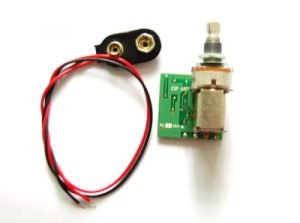Artec EXP Review – Artec Expand to Peak Controller – Onboard Booster
 Artec EXP & EX3 Expand to Peak Controller review
Artec EXP & EX3 Expand to Peak Controller review
Artec EXP is an excellent and affordable onboard booster that you can easily install on any electric guitar and bass.
It has three functions in one device.
- First: the frequency expander
- Second: mid-band peak control
- Third: flat booster
You can get two different versions of Artec EXP. The regular EXP model mounted on a push-pull potentiometer and the EX3.
The EX3 is the same circuit with a three positions toggle switch instead of a push-pull. It gives less control than the pot version, but if you lack room for your instrument, and you can’t add an extra potentiometer this is the way to go.
>>> Multi effects for guitar <<<
The frequency expander
When the potentiometer is on 10, it is a bass and treble boost. It gives a crystal-clear tone to the guitar.
Mid-Band peak control
When the pot is on 0, the EXP acts as a mid-boost.
Flat booster
When the pot is in a middle position it is a neutral boost. It increases the signal without changing the tone of the instrument.
With the push-pull version, you can fine tune the boost effect. With the EX3 it’s all or nothing.
In the video included in this article, I’m comparing the Artec EXP onboard booster installed on three different custom guitars.
Even if I own an EX3 version of the Expand to Peak Controller, I do not test it in this video for the simple reason that the pickguard it is installed on is not placed on any guitar at the moment I was shooting the video.
You can install the EXP on any guitar or bass. Be it active or passive pickups.
As I explain in the video, the bigger the regular output of the pickup is, the less efficient the booster is going to be. On an active guitar, you won’t hear much difference with the Flat booster. On the other hand, if the pickups have low output, the boosted signal will not be as powerful as what you get with a loud pickup.
>>> Demon TS808 Tube Screamer<<<
>>> Herve Senni Streaming Sites Catalog<<<
The effects used on all guitars are the same:
- Soul Food
- Reverb
In the intro, I’m using some delay that I turned off in the remaining of the video.
First Guitar
The first guitar used in the video is a custom Stratocaster I built, featuring Artec HXTN Hot Rail Humbucker pickups. Those pickups have a ceramic magnet and are incredibly powerful. The neck pickup is 9.6 ohm, and the bridge pickup is 15.5 ohm.
Because of that high output, the flat boost is not as effective as it is on the two other guitars featured in the video.
Depending on the pickup output volume, the distortion sound sounds more or less heavy, with and without the EXP. It’s normal. That is the exact and main reason why I have so many guitars. Because effects react differently depending on the pickup installed.
>>>Distribute Your Music @Distrokid<<<
Second Guitar
The second custom Stratocaster features Artec P51 Humbucker vintage pickups in the neck and bridge position and a Gretsch Electromatic Lap Stell guitar pickup in the middle position.
The Neck is 8.4k, and the bridge is 16k. Even if the numbers are almost the same as the Artec HXTN, the overall output is much lower using the Artec P51. They must operate at a different frequency. Those pickups sound brighter than the Artec HXTN. Because of that, the flat boost is more efficient on that guitar than the first one. The distortion sounds thinner too.
Third Guitar
The third and last guitar used in this video feature Chinese copy of the vintage wide range pickups from Fender. But they have the regular humbucker mounting screw instead of the 4 bolts feature on Telecaster models.
Pickup’s resistance is:
- Neck: 7.80 K ohm
- Bridge: 11.7 K ohm
>>>Guitar Pedals<<<
 They are the lowest output of the three, and therefore they sound the warmest and least aggressive of the three guitars.
They are the lowest output of the three, and therefore they sound the warmest and least aggressive of the three guitars.
The middle pickup is a neck pickup from a Telecaster I bought at GFS. It is a slick model and sounds really good too. But I didn’t use it in the video to demo EXP.
It is incredibly easy to install. The most complicated part is to find a place to locate the battery. As demonstrated in the video, I had to route a slot to insert a battery case. If you do not use your vibrato, you can slide the battery in between springs or you can place it inside the pickup rooting. If you take that last path, you’ll have to remove the pickguard every time you’ll have to change the battery.
Feel free to ask or comment on this article using the contact form below. I’d be happy to help you or read your point of view.
![]()
|
I am Hervé Senni, a pro musician and performer, Composer and arranger for quite some time. My main musical instrument is the electric guitar. I am also a bass player, mandolin, Ukulele player. I also invented string instruments.
Over the years, repairing and improving electric guitars that did not have to be upgraded converted me into a self-taught luthier.
This post is also available in: French

 Distribute your music using Distrokid
Distribute your music using Distrokid





Watched all your reviews and videos, if you had to choose one, would you prefer the BCU or EXP?
Hi Dean. I answered you on Youtube already. I like both, but I like the BCU better. The EXP is a three positions booster “only.” It is a bass, neutral, and treble booster, depending on how you set the pot.
The BCU is also a booster but modifies your pickups’ tone. It changes a single-coil tone for a humbucker and a humbucker for a single-coil sound. Like I said on YT, it depends on your pickups and what you want to achieve. If you have a strat only and you would like to get at fatter sound without changing pups, then a BCU is the one you need.
If you have a medium or low output pickup set and want to get more drive for soloing, then the EXP is better.
You can also have both and bypass the tone pot.